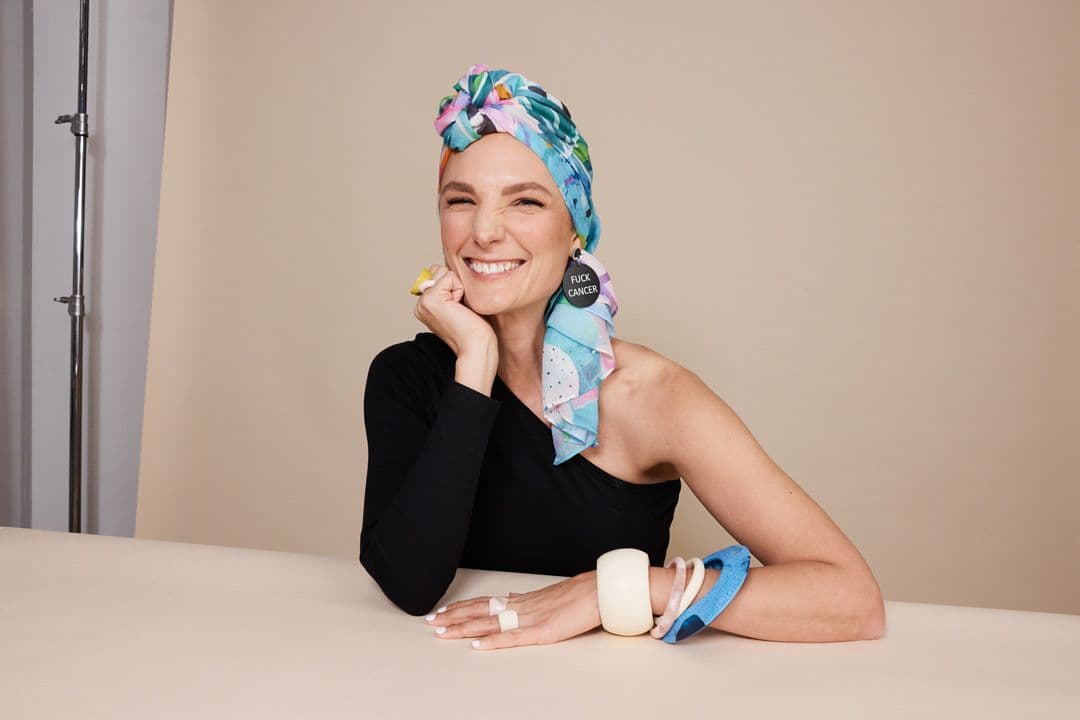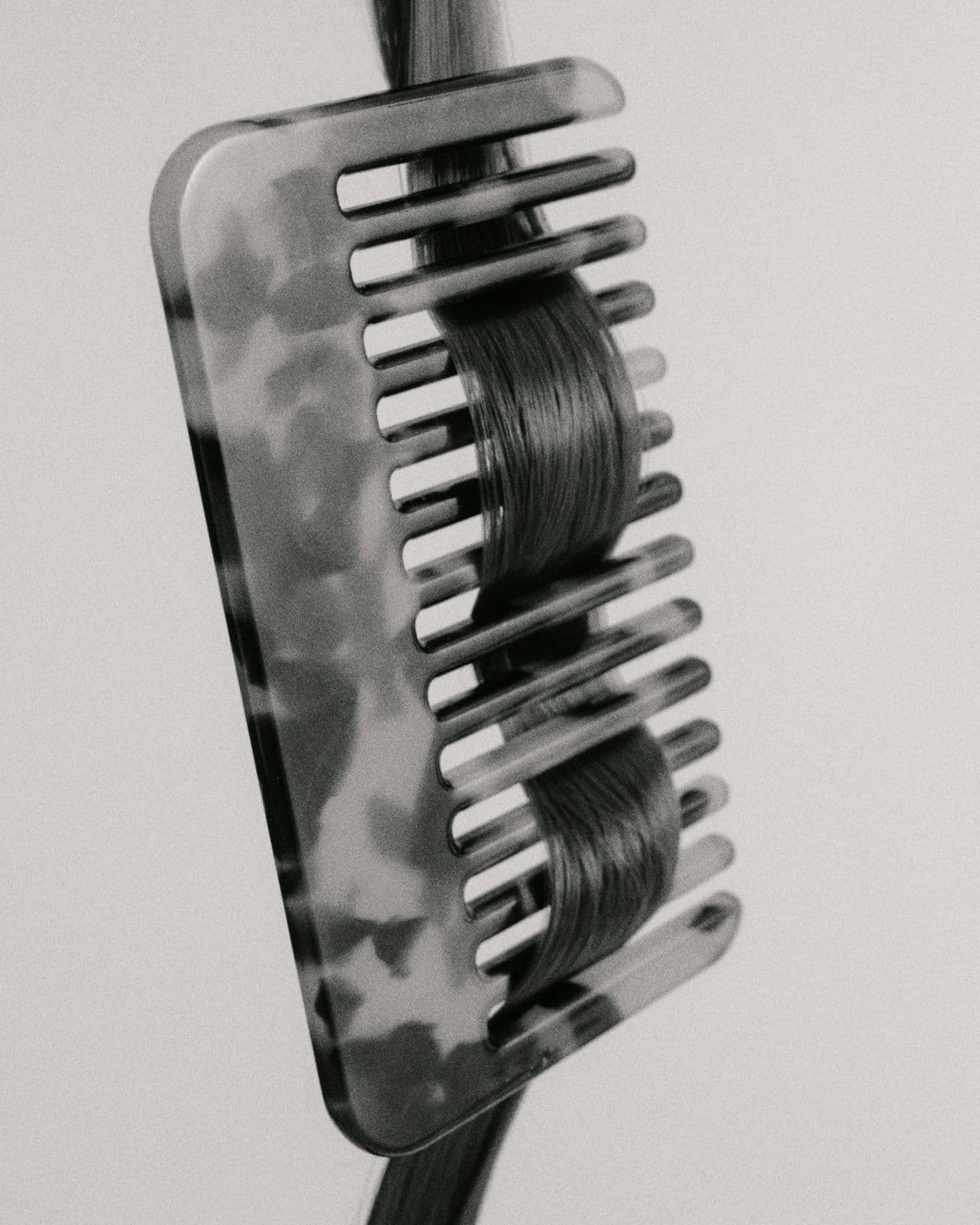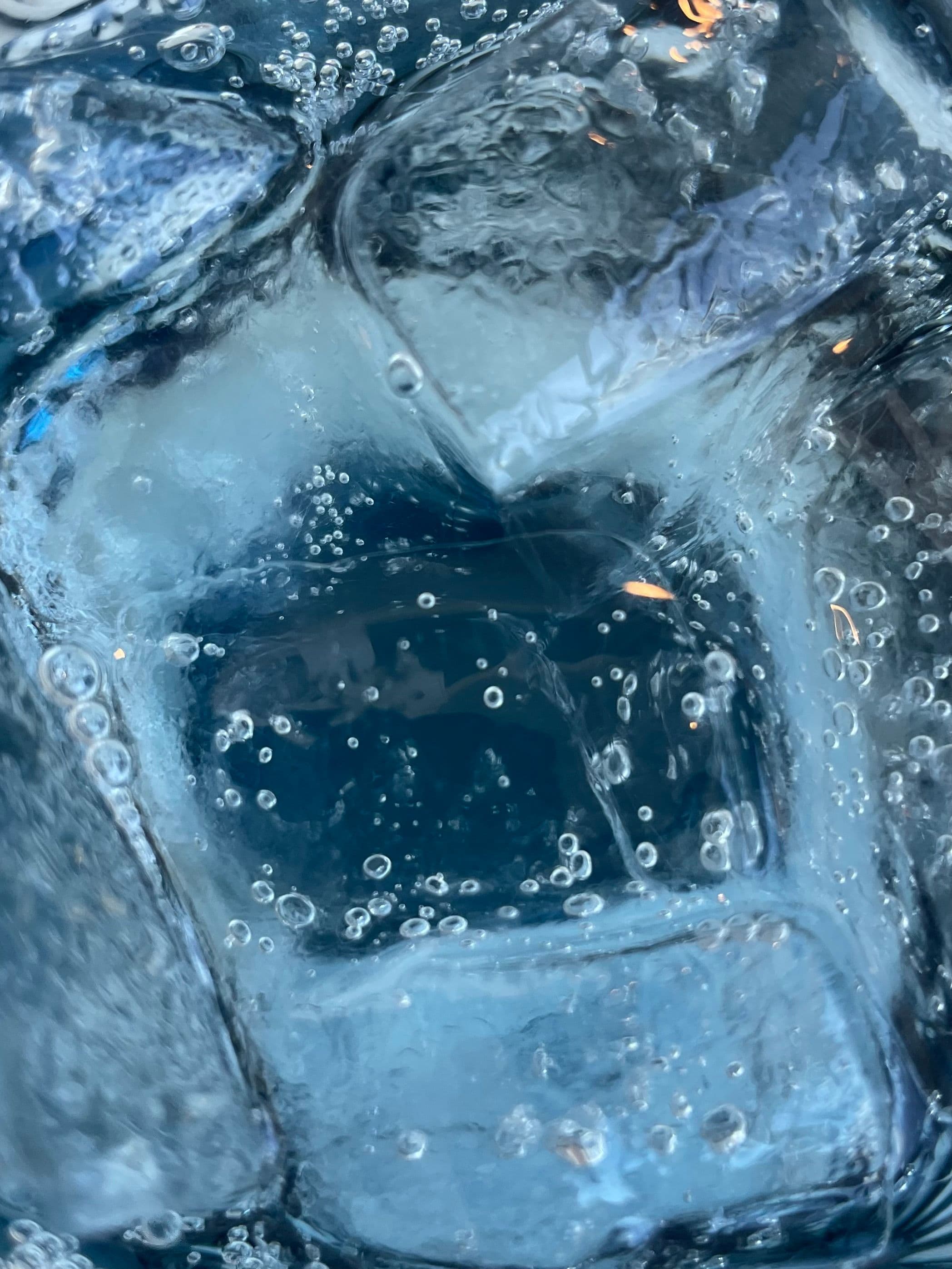Emily Somers is an Australian designer, the founder of head scarf company Bravery Co., and a disarming wit-wisdom dispenser about the experience of cancer. When she was diagnosed with Hodgkin lymphoma for the first time in her mid-twenties, she was determined to wear wigs and present herself as something very different from the elderly figures she saw in brochures. Diagnosed for the second time, soon after, she changed her mind. It was bright, bold head scarves for Emily. And after her third diagnosis, she had already been designing the scarves herself.
I am going to rock up with a big scarf on my head and bring the color and bring the big bling earrings and a bit of lipstick and give cancer a bit of a ‘fuck off’.
Emily founded Bravery Co. which makes beautiful, sustainable head scarves designed exactly for people with medically-induced hair loss. Below, Emily talks to Jadey about her diagnosis-induced love of color, the transformative power of style, and exactly what to look for in a head scarf.
Q:
Did your experiences with cancer change your personal style?
A:
Very much so and in so many different ways. The first time I had cancer, I was just turning 27. I worked in an advertising agency in Melbourne, which is the cool city in Australia. We are known for dressing head to toe black, very chic black, especially if you're in the design realm.
The first thing that happened, a couple of months of being in cancer land, was I just didn't want to wear black anymore, because it made me feel like I was dressing for my own funeral. I just needed color. That was huge.
That was a big pivot in my wardrobe and in my life, because I felt like when I started dressing with color, it kind of gave me a way to start the day with pep and energy. When I was dressing in black, it just made me feel a bit drab. I think it's hard not to feel a little bit, even if it's only five percent, more happy when you have something colorful and fun on. Then you attract other people, who will say, ‘You look great today! Look at all this color!’
I think that's when I started to realize the power of color, the power of dressing happy, and what it can do for yourself, and what it can do for the people around us as well.
It meant that me and my mum and I went on quite a few shopping sprees, which is also a really nice thing to do when you're feeling a bit meh about life.
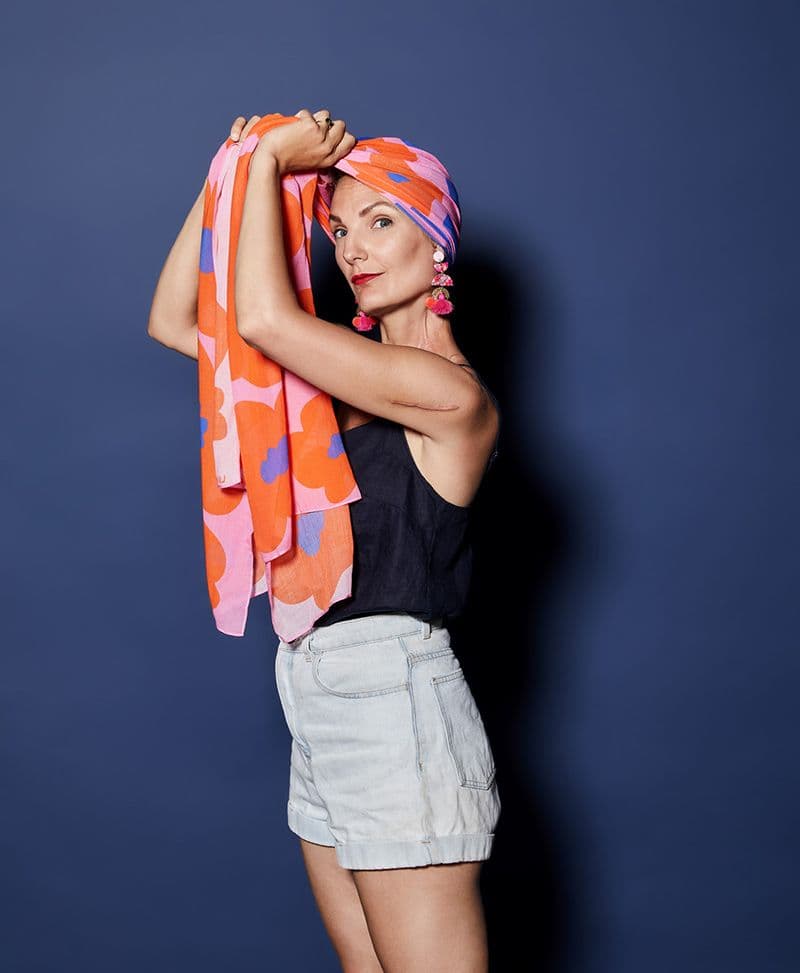
Q:
Tell me about these shopping sprees; I wish I’d done something like that. It feels like a permission to treat yourself, and I was so locked into thinking, ‘this is temporary, I won’t get anything nice for this situation because this is temporary.’
A:
Well, maybe I did it because I was 27. Maybe now, I’d say, ‘Oh this is not necessary.’ This is also before we realized what a terrible thing fast fashion was.
This is advice that I give to girls that are going through it, whether it's cancer or something really horrific. I say, ‘Go ahead, spoil yourself, because you deserve things to look forward to. Or little presents along the way. Whether that’s going outside and having a beautiful walk or a big, long soak in the bath.’ These things don't need to be expensive or fast fashion.
I've still got pieces of jewelry—they were $100 or something, which, as a 27-year-old, that’s a lot!—from back then. They make me think, ‘Oh I bought that one when I got a really crappy scan and I was really scared, and I thought, I want that pretty thing. I deserve that pretty thing today that I've been looking at for a month. I'm gonna buy it.’ And I'm so glad I did. Because they represent so much more than just a pretty thing. They represent a really scary time and me band-aiding it with a little reward. It did make me feel better. I know it's very vain, and I know it's kind of superficial to buy things, but if they’re things you love they do make your heart happy.
Relish this thing forever, because this will remind you of a really dark time, and when you have it later in life, it will bring you so much happiness and so much pride to think that you got through that—and well done.
Q:
How did different clothes change how you felt?
A:
I have always been quite a confident person, but having days when going through treatment, when I've lost my hair, when I've got absolutely no color in my face, I’d have to deal with leaving the house and trying to find ways that make me feel comfortable. Normally I'd be happy just leaving the house in tracksuit pants, and I'd have the confidence just to be like whatever, I don't care what the world thinks. But when everyone can see that you're sick— and it's the pity stares that are really unavoidable—finding style that gave me the armor to leave the house. Some days that was in color, sometimes that was with big head scarves. Other days it was to just try and find ways to fake looking healthy.
Being sick, it really makes you realize that fashion isn't just fashion, and clothes aren't just clothes. They do give you this extra comfort and boost when you need it.
Q:
Did faking looking healthy make you feel healthier? Could you fake it to yourself?
A:
I think so. During that time, I realized how much just starting the day by drawing on some eyebrows, putting on some bronzer, and [then] seeing that reflection in the mirror that doesn't look like a cancer patient, it did set the tone for the day. Even if no one sees me that day. And sometimes it's only a slightly better day, but it's going to be a slightly better day. Just looking in the mirror and seeing that you do look healthy that’s super powerful.
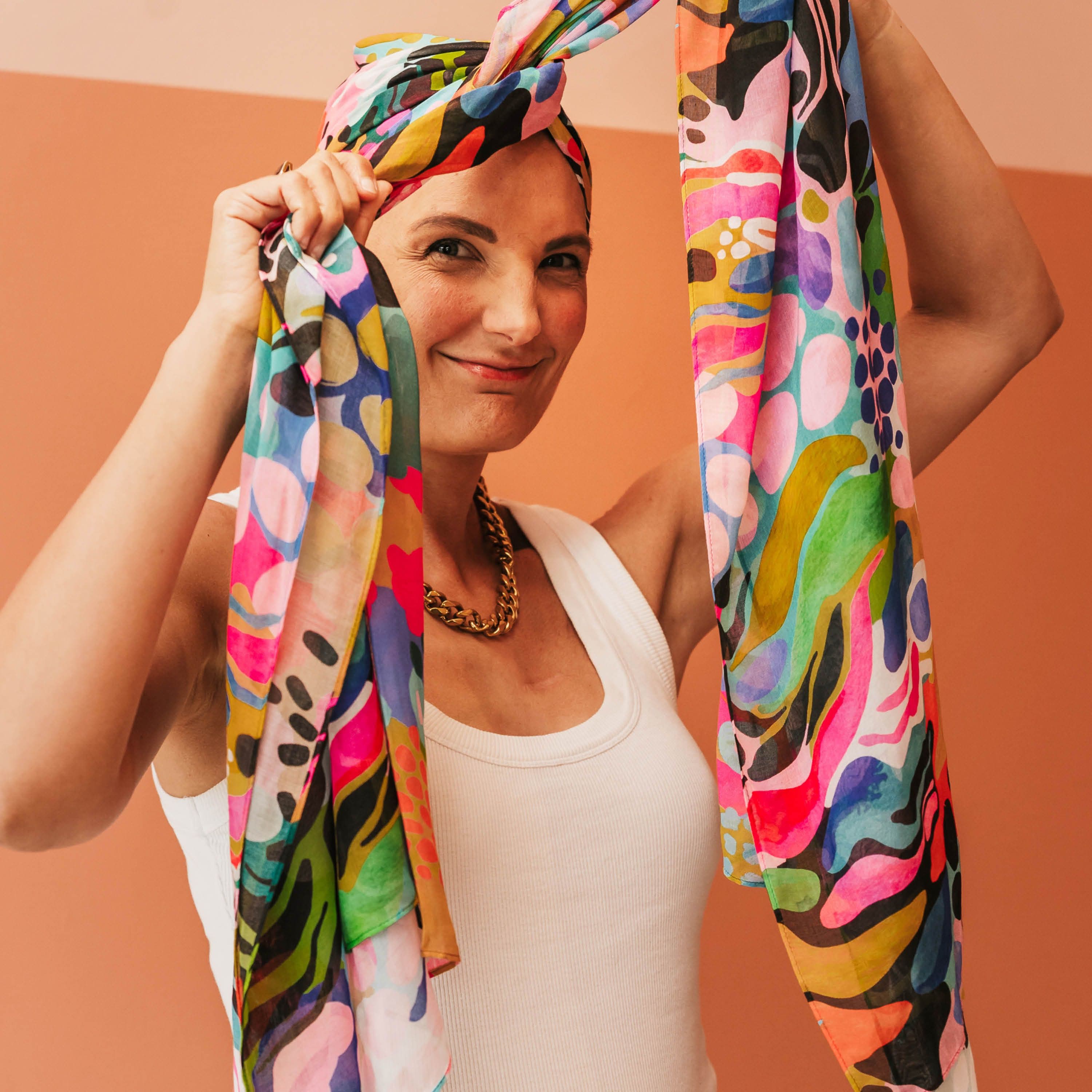
Q:
Did you think of this as trying to feel like yourself or trying to feel different? Did it matter?
A:
That’s interesting. I don’t know. I think I was just trying to do things that made me feel happy. I was also trying to find ways to not feel like a cancer patient. At that point, social media and Instagram was only just starting to take off. Now there are so many groups, so many influencers that have had cancer or that have something to do with cancer charities, so you get to see quite a range of what a cancer warrior, or what I call cancer warriors, look like. Back then all I had were the brochures from the hospital. They showed much older people, and they were always dressed in these flowy, pale, really baggy clothes.
I was just like, I am not that. I wanted to look the opposite of that. I wanted to look like I didn't belong in this hospital. I was just trying to find ways to be like, Yes, I am that younger person. I don’t belong here. I'm going to dress with fun colors, and I am going to put a little bit of effort into what I look like, because I refuse to look like the cancer patient that I have been shown in movies and in hospital brochures.
Because I am not going to be the cancer patient that dies. I think I was just trying to find a way to swing the pendulum the exact opposite way. In my mind, this was how I was going to do it. It was one of the only areas of control that I still had left when everything was run by doctors and appointments and scans and treatment. This is what I could control, and this is what could make me still feel young and like the 27-year-old I was.
Q:
You started Bravery Co.—and you have these gorgeous, bright, boisterous and fun head scarves designed for people with cancer-induced hair loss. It feels both about keeping one’s style, but also about reclaiming the narrative in your head about what this time looks like. Is that a fair leap?
A:
There are often two types of cancer warriors. And I was both of these. One will just be like, I just want to wear wigs because I don't want anyone to know, and I want to go underneath the radar. And then there's another type of cancer warrior, which I was after my second diagnosis, which is a bit like, Fuck it. I want scarves, and I want the color, and I don't care if people give me a second glance. Because on my good days, I have the confidence. On bad days, these scarves give me that extra confidence to kind of go against what a traditional meek cancer warrior cancer patient is meant to look like.
On the good days, you can harness that cancer attitude and be like, I am going to rock up with a big scarf on my head and bring the color and bring the big bling earrings and a bit of lipstick and give cancer a bit of a ‘fuck off’.
Q:
What was the aesthetic for Bravery Co., besides your personal style, that you wanted to capture?
A:
I wanted to make sure that they had cool, cool prints on them. I wanted really bold and strong prints, because I think a lot of scarves out there are very girly and feminine in that soft, lovely way. But I think when you wear that on your head, quite often, you can look like you're wearing pajamas on your head. So I wanted mine to be stronger and punchier with the designs.
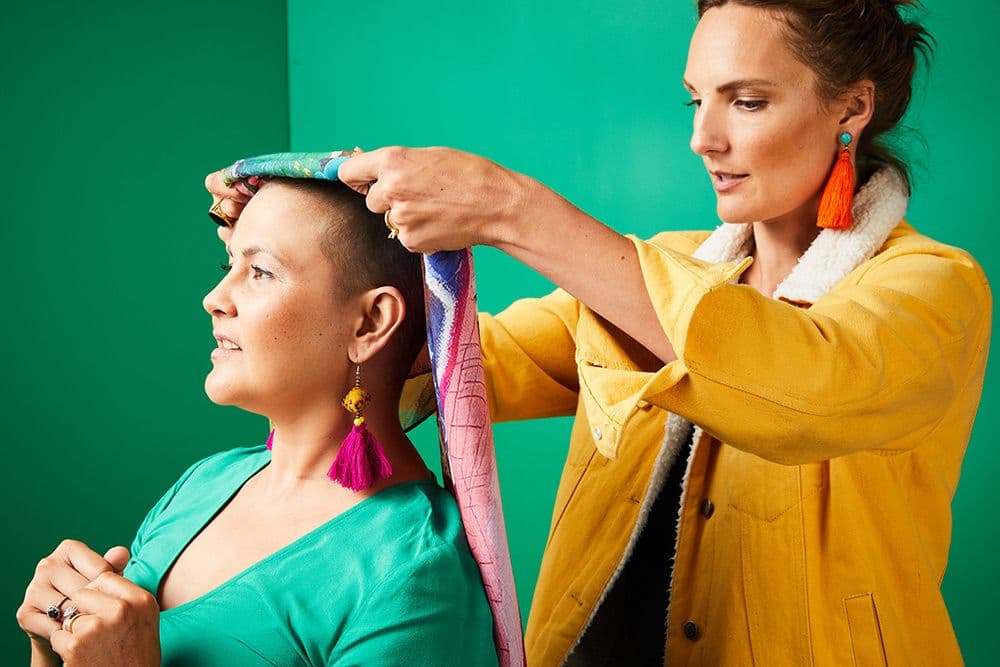
Q:
For someone going through their closet, or shopping for head scarves: what are the qualities they should look for? Dimensions?
A:
Ideally, you want about 70-100 by 200 CM (27.5-39 inches by 79 inches). This gives you enough fold over so it's not so see-through, and you can do lots of different twists and styles. You also need them not to have sequins [which will scratch] or too much embroidery. You need a breathable fabric, and a really soft one. Sometimes chemo makes your head super sensitive. And breathable, because a lot of people go through menopausal kind of symptoms, with hot flashes.
And a tip I give, with vintage silk ones, which I love wearing: they are often quite slippery on your scalp if you have no hair. So get a fabric headband, like a flat makeup headband, and put it underneath. You can tie up the scarf over the top and it gives it something to grip on to. Also, with scarves with embroidery or sequins, they can be ways to wrap it so that part is not sitting on your head.
Q:
Any other crucial tips for the new head scarf wearer?
A:
Yes. So we have tutorials on Bravery Co. about how to tie them, but it takes time. You’ve got to have a sit-down in front of the mirror. For the first half an hour, you're probably not going to manage it. It’s a practice thing, and you've got to bring your sense of humor. Some of them are going to look awesome and some of them are going to look ridiculous on your head. There's some that I tie on my head—ones that look amazing on other cancer warriors, like the girls who do a big bow—and I just look ridiculous. You just have to spend a bit of time playing and experimenting and having a bit of fun, like you would with new makeup or anything, to find what suits your head and your style.
